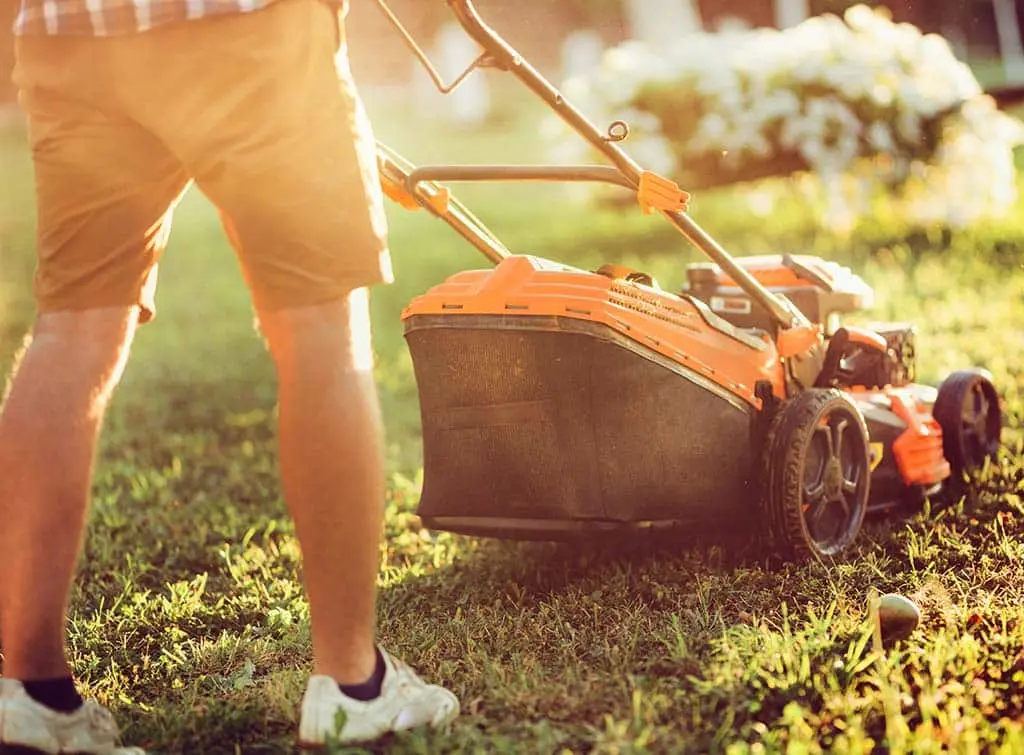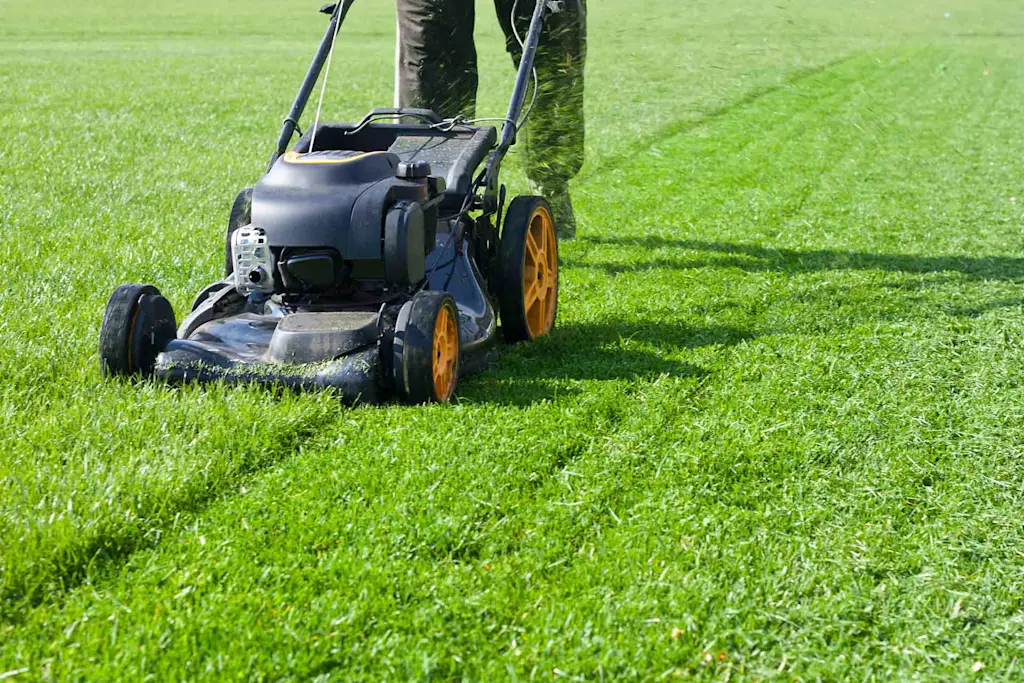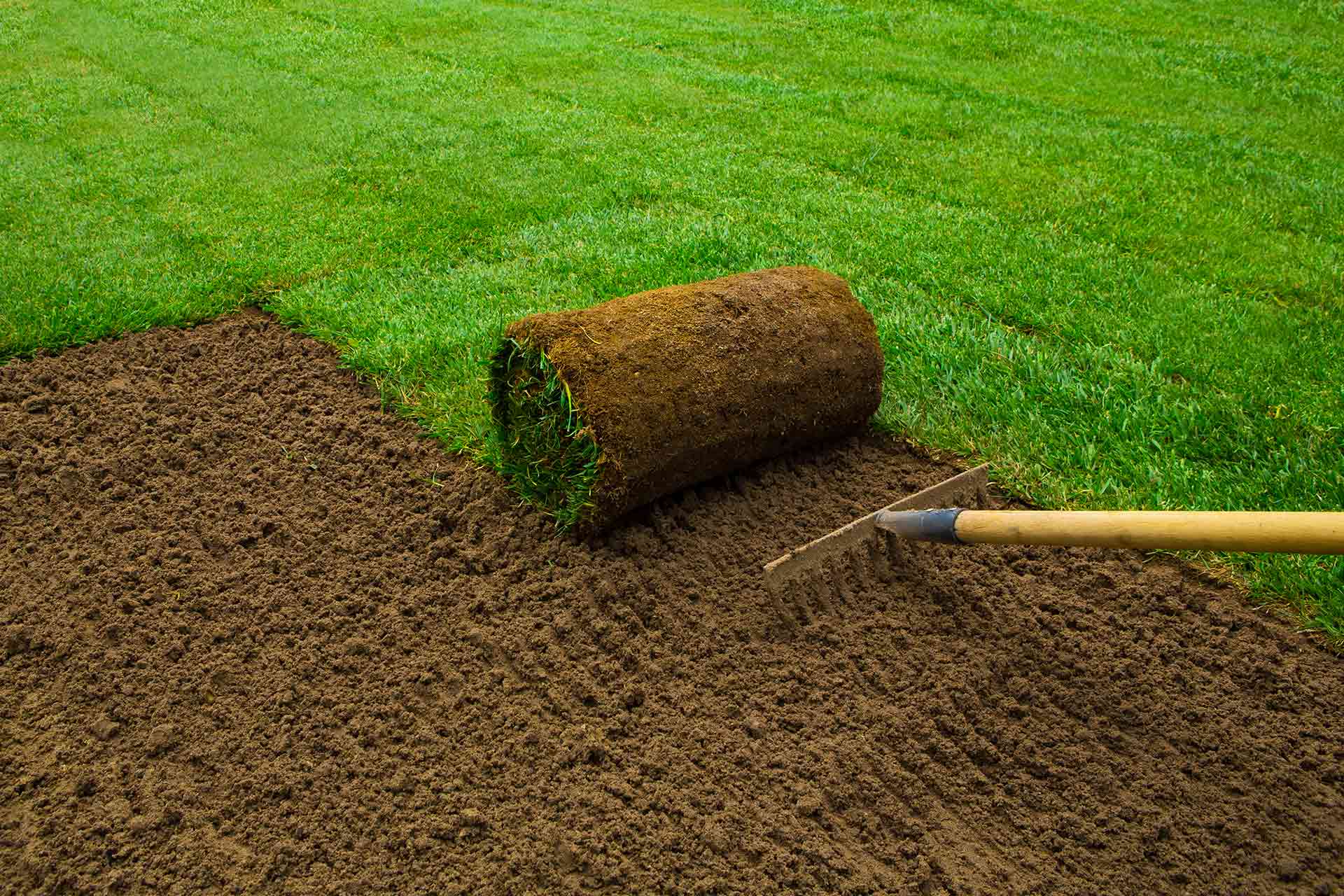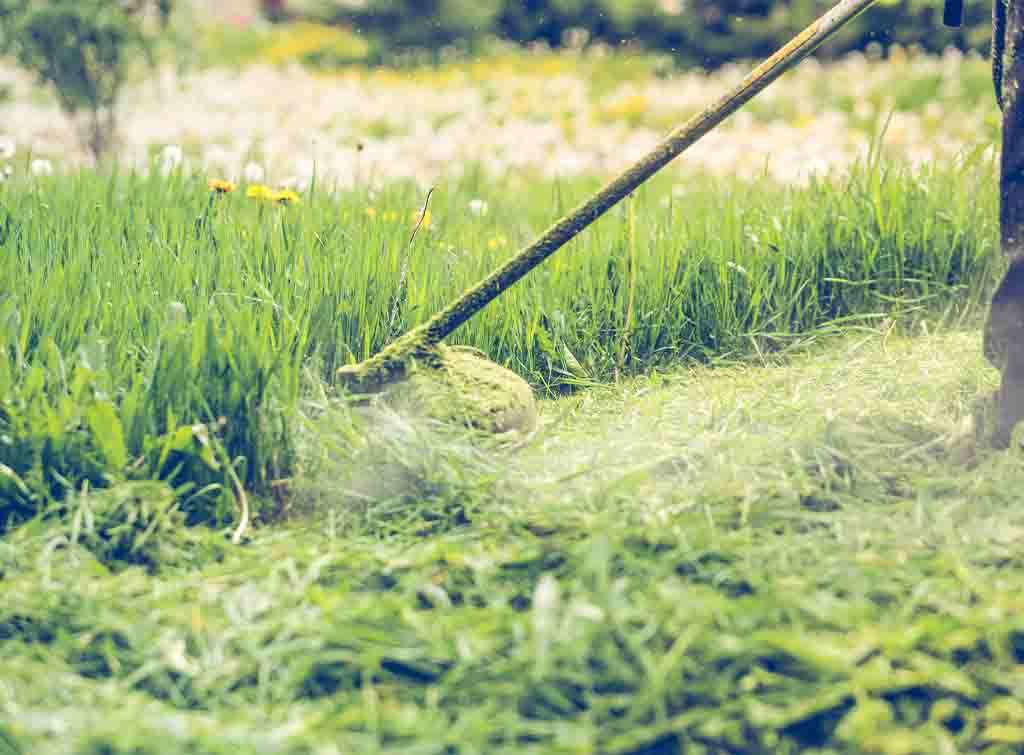Blog>Expert Advice>Lawn mowing tips: How to make your grass look great
Last updated: 31 May 2024
Lawn mowing tips: How to make your grass look great
Mowing is the key to a neat, healthy lawn. And it's an essential job for the spring and summer months. Make sure your lawn is the envy of the neighbourhood with our lawn mowing tips.

The best way to encourage healthy, lush grass is by regularly mowing your lawn. Each cut helps keep a lawn neat and encourages denser turf. Mowing also blocks out weeds and makes the grass more hardwearing.
During the growing season, mowing the lawn can take up quite a lot of time. That's why it's so important you know how to cut grass the right way.
In this post, we’ll guide you through how to mow a lawn and some useful grass cutting tips to make sure every last detail is covered.
Prefer to call in the experts? Search our leading directory to find experienced grass cutting services in your local area. Enter your postcode into the box below.
See the tradespeople we've checked and recommend for your job
Lawn mowing advice
Lawn mowing shouldn’t be a chore. With our handy grass cutting tips, you can save time and effort and keep your lawn looking good.
How often you should mow your grass and cutting at the correct height will help your lawn stay dense and healthy. Lawn mower maintenance is also key to a neat and healthy lawn.
It's time to take pride in your beautiful lawn with our grass cutting advice. But if you'd prefer a professional to take on the job, read our blog to find out how much different lawn treatments will cost you.
Read on for the best lawn mowing tips and tricks.
1. Get your mower serviced regularly
Getting your mower serviced at the start of every growing season is important to ensure a clean, quality cut.
Chipped or blunt blades will bruise the grass and cause a silver sheen or frayed look to the lawn.
Also, don't forget to clean out your mower regularly to avoid a build-up of clippings.
2. Know how often to mow
How often you mow depends on the style of lawn you want, weather conditions and the speed your grass is growing.
Here's some grass cutting advice:
The more frequently you mow, the denser your lawn will be
In early spring, grass needs cutting less frequently as it grows more slowly at this time of year. Cut fortnightly until the weather warms up in late spring
Lawns need cutting weekly in late spring and summer. You may even need to mow twice weekly when growth rates peak in late spring
If you mow less frequently you'll break the 'one third rule' as you'll have to cut off more than a third of the grass height to keep it looking neat
Milder winters mean lawns may benefit from occasional mowing between late autumn and early spring
Let your new lawn grow to 5cm (2in) tall before mowing for the first time. Choose the highest blade setting so the mower doesn't get choked with clippings. If the grass is really long, you may need to strim it first
Dry shady areas under trees may need less frequent mowing than areas in full sun with good moisture levels

3. Get the grass height right
One of the key grass cutting tips to a lush lawn is knowing what height to leave the grass.
Most lawn grass is best kept at 2.5cm - 4cm tall. Leave it a little longer in patches that get more wear and are heavily used, say 4cm - 5cm.
In the shade, you could leave it still longer, at 7cm-8cm.
Have you thought about... No Mow May?
If you want to encourage wildflowers in your lawn, try No Mow May. As the name suggests, you stop mowing in early May, which allows the wild plants already in your lawn to grow and flower.
Whether you leave your whole lawn uncut or just a section, no mowing will add colour and attracts pollinating insects and other wildlife.
4. Adjust the cutting height
Cutting the grass at the correct height will help your lawn stay dense and healthy.
To do this, you'll need to adjust the mower's cutting height to suit the weather and season. The mower should be on the highest setting for the year's first cut.
After that, aim to keep grass around 4cm tall in spring, autumn, and winter, and about 2.5cm in summer.
If it's a hot summer, it's a good idea to raise the cutting height of your mower blades to leave the lawn longer. This will make it less prone to going brown in dry weather. The longer grass also retains extra moisture, helping to keep the lawn green and offering shade to the soil.
5. Mow in fine weather
Avoid mowing your lawn when it is wet, or temperatures are too cold.
If you cut the grass when the ground is soaked, the mower will smear the soil and grass clippings will clump together.
Mowing should wait until frosts have passed. With milder winters and the grass continuing to grow all year, many of us are now cutting our lawns all year round to some degree.
Mow like a pro - the finer details to perfecting your lawn
These are more advanced grass cutting tips to make your lawn stand out from the crowd!
Earn your stripes: If you want a striped lawn, begin my mowing a straight line down the middle of the lawn. Now mow on either side of it
Make slight overlaps: Each run up and down the lawn with the mower should slightly overlap with the previous one (Make an overlap mark on each side of the mower to make this easier)
Don't forget edging: A final cut or two all around the perimeter of the lawn will add a professional finish to your lawn mowing
Change direction: Swap mowing direction at least every month so you don't get tramlines and ruts and to stop grass permanently leaning in one direction
Create compost: Be sure to compost grass cuttings and mix them with plenty of carbon-rich material. In the summer, leave the clippings on the lawn to help retain moisture
Let new lawns grow: Avoid mowing newly sown patches of lawn until the grass is 4cm tall, then cut them along with the rest of the lawn
Read our blog on how to hire lawn care and grass cutting services for loads more advice.
Look after your mower like you look after your motor
Good mower maintenance is key to a clean, quality grass cut.
You'll need to maintain your mower all year round - a mower isn't just for Christmas!
Gardners World estimates the job to maintain your mower will take around 15 minutes. The jobs include:
Checking if the spark plug cap is clean
Checking your oil level but checking the dipstick
Checking the air filter
Wiping all parts of the mower with oil, which cleans and protects it from rust
Wiping the underside of your mower to clear any grass build-up
And finally, a quick wheel check to make sure they are turning ok or whether they nee tightening up
Staying safe when cutting your grass
What you'll need to mow your lawn safely:
Lawn mower
Sturdy shoes
Ear defenders (if necessary)
Residual current device (RCD) for electric mowers with cables
A garden rake for collecting grass clippings
Long-handled edging shears for trimming lawn edges after mowing
For a step-by-step guide on how to cut grass properly, head to our how to mow a lawn blog.
Or, hire a professional gardener to cut your grass!
See the tradespeople we've checked and recommend for your job
Contact or pay a trade through Checkatrade and you’re covered by our 12-month guarantee of up to £1,000*

FAQs
What is the correct way to mow a lawn?
Mow up and down in straight lines and overlap each row slightly so you don't miss bits. If you have any irregularly shaped lawn, start with a line across the middle, and then mow one side at a time.
Check out our step-by-step guide on how to mow a lawn.
Do you strim or mow first?
If the grass is really long, you may need to strim it first to reduce the overall height, then rake up the cut grass, before going over with the mower to tidy up as best you can.
Do you mow back and forth?
It’s a good idea to vary the direction of cut regularly, alternating straight lines with diagonal stripes. This will help prevent ruts forming in the lawn which can occur from going backwards and forwards in the same direction too often.
Is it better to strim grass wet or dry?
Wait until the grass is dry before strimming a lawn. Mid morning is a good time to strim, when the dew has evaporated and the summer sun isn't blazing.
What is the best time of day to cut grass?
Mid morning or late afternoon is usually the best time to mow the lawn. If done too early, the lawn will be damp with dew which can cause the grass to tear rather than cut cleanly, leading to disease. Midday can be too hot, the intense sun can stress the newly cut grass.
Should I leave grass clippings on my lawn in the UK?
When you mow during the spring and summer, leave the grass clippings on the lawn. As they decompose, they release up to 30 per cent of the lawn's required nutrients. Remove the clippings from the lawn at the beginning and end of the growing season when decomposition is slow.
Should you edge your lawn every time you mow?
Trim edges regularly is the main advice - maybe after each time you mow your lawn during the growing season. Every time you mow your lawn, assess the lawn's edges. In the early part of the growing season, warmer temperatures and more rain can lead to a growth spurt so you might need to mow and edge more frequently.
When not to cut grass?
Sometimes cutting your lawn can do more harm than good. Never mow when the grass is wet or it's too dry, it's diseased or you've just fertilised.
Likewise never mow frosty grass as it can damage your turf and compact the soil. Wait until later in the day when the lawn has dried out or defrosted. Or postpone mowing to another day.
Should you mow fast or slow?
The faster you mow, the less time your mower blades have to make a clean cut. Moving too fast can result in uneven grass which can make your lawn more susceptible to disease.
It's generally accepted that the best speed for effective mowing is in the 3-6 mph range. Slow mowing allows for a smoother, cleaner cut. Your lawn will look better plus it will promote good grass health.
How long after rain can you mow?
On average wait between two and five hours after a light shower - longer if the rain was heavier - before you consider getting out the lawnmower. The key is to wait until the lawn is dry.
A good test to see whether the grass is dry is to walk on the grass in sandals - if your feet stay dry then you're good to go.
Can you mow over leaves?
You should remove fallen leaves from your lawn so they don't smother and kill your grass.
However instead of raking the leaves, you can use your mower to mulch your leaves instead.
Wait for the leaves to dry a bit, then take off the grass catcher. Set your lawnmower blades higher to safely mulch up fallen leaves as you mow. The shredded leaf pieces will decompost into the lawn adding nutrients back into the soil.
Is it OK to cut grass every 2 days?
It's important to adhere to the one-third rule. That is, mowing your lawn to one-third of the grass' height and then letting it recover for three or four days before mowing again.
In spring and autumn mow at least every 7 - 10 days if using a rotary mower and at lease every 3 - 5 days if using a cylinder mower. In dry summers cut this back to once a week or fortnight.
How short to cut grass?
Never cut more than a third of the blade of grass off in one go. Cutting more than this can stress the grass.
Most lawn grass is best kept at 2.5cm - 4cm tall. In patches that get more wear and are heavily used, leave it a little longer, say 4cm - 5cm. In shade, you could leave it still longer, at 7cm - 8cm.
Excessive close mowing can weaken the grass, encourage shallow rooting and make the lawn susceptible to drought damage, weeds and moss.
Finding the time and energy to care for your lawn yourself can sometimes be a challenge. So, why not hire a professional grass cutter near you to get your lawn in good nick?
We check and approve every member within our leading directory so you can be sure you’re getting the very best service.
See the tradespeople we've checked and recommend for your job
More Expert Advice Articles
See the tradespeople we've checked and recommend for your job





